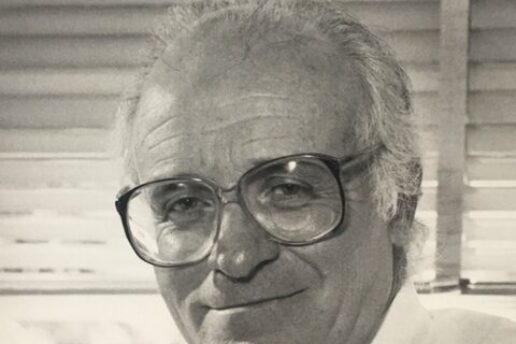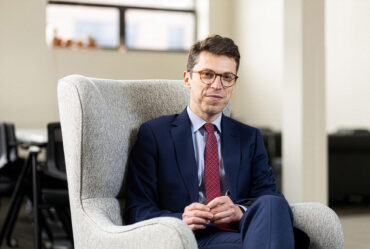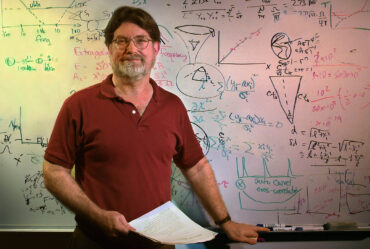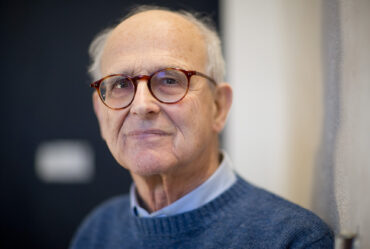
Professor Emeritus Bernard Burke, astrophysics pioneer, dies at 90
Former Astrophysics Division chair discovered radio noise from Jupiter and the first Einstein Ring, and developed tools to map the universe.
Bernard F. “Bernie” Burke ’50, PhD ’53, the William A.M. Burden Professor of Astrophysics Emeritus and a principal investigator at the Kavli Institute for Astrophysics and Space Research, died August 5. A resident of Cambridge, he was 90.
A former chair of Physics’ Astrophysics Division, Burke was an innovator whose research into radio astronomy stretched our view into the farthest reaches of the universe. His most notable achievements included the discovery of decametric radio noise from Jupiter, for which he earned the Helen B. Warner Prize of the American Astronomical Society in 1963, and the first Einstein Ring. He played a key role in developing very long baseline interferometry (VLBI), which allows high-resolution imaging of cosmic structures, and the Very Large Array (VLA) radio telescope, to aid in his research of gravitational lenses, quasars, and galaxies. Burke is the co-author, along with F. Graham-Smith, of Introduction to Radio Astronomy, now in its 3rd edition.
“Those of us who have been here a while remember many decades of his humor, energy, intellect, and zest for life,” said Jacqueline Hewitt, Director of the Kavli Institute for Astrophysics & Space Research, and one of 19 students mentored by Burke. “This is a great personal loss for me, and I know many at MKI who were close to him share my sorrow.”
The Early Years
Bernard Flood Burke was born in Brighton, MA, on June 7, 1928, the son of Vincent, head of the math department at Rindge Technical High School, and Clare, a statistical typist who devised her own method to manually type complex math formulas. He worked summers in a nursery and in his uncle’s laundry, and in his spare time loved hiking in the White Mountains, rock climbing in the local granite quarries, and playing violin. But a glimmer of his future career began with a love of sitting for hours doing math problems; and when he was 16, he and a high school friend purchased a large piece of glass to grind it into a telescope’s lens. “They enjoyed the challenge involved to shape it and grind it correctly,” said Burke’s sister, Sally Berenson.
After he graduated from Lexington High School, a major conservatory offered a full scholarship to study the violin, but he chose MIT, at first to pursue engineering. “One day he turned to a friend, John Irving, and said he would major in mathematics and physics, not really knowing what this would entail exactly, but because they were reputed to be the most difficult classes and he wanted a challenge,” said Burke’s daughter, Elizabeth Kahn.
When he served in the ROTC’s Signal Corps, he learned Russian, worked under a noted decryption specialist, and was promoted to first lieutenant. When he graduated from MIT in 1950, he was tapped to work on Project Hartwell, a US Navy-MIT collaboration that researched long-range underwater acoustic detection sensors for anti-submarine warfare.
He continued to study physics and astrophysics, with a focus on microwave spectroscopy, as a graduate student under Professor Malcolm “Woody” Strandberg. After receiving his PhD in 1953, Burke joined the Carnegie Institution of Washington’s Department of Terrestrial Magnetism (DTM), as a radio astronomer. He designed and constructed radio interferometers, radiometers, and radio telescopes under the famed DTM director Merle Tuve, an innovator in the use of pulsed radio waves to study the ionosphere.
At DTM, Burke was a “pioneering scientist who has had the vision, the expertise, and the drive to be always at the cutting edge of radio astrophysics since he took his PhD at MIT,” recalled Physics Professor Emeritus George Clark, during his introduction of the Gravitational Lenses conference held in honor of Burke’s 60th birthday. “Bernie was prepared to implement his youthful judgment that there was scientific gold beyond the obscure foothills of radio astronomy.”
A Major Discovery
And then a routine survey launched a career filled with awards and breakthroughs. In 1955, he and his colleague Kenneth Franklin set out to map the northern sky using a radio antenna array, with receivers housed in an Army surplus truck parked in the middle of the rural 96-acre Mills Cross field, near Washington, D.C. One night, they thought that they were picking up a sort of hissing sound they at first thought came from the spark plugs from a Maryland farmhand’s vehicle, which was driving home late that night. “It was an easy mistake to make,” said Rachel A. Weintraub of the NASA Goddard Space Flight Center.
But when they tested the array and moved it in a southern direction, they detected bursts of radio radiation. After looking over their data, they realized that the emission occurred about four minutes earlier each night over several months. By comparing this information against other celestial objects, they realized that they had actually been listening to Jupiter, and that other scientists had been discarding such data for years. Comparing their new data with what scientists already knew about the planet, they realized that the radio bursts matched up with Jupiter’s rotation rate of once every 10 hours. They presented their findings on April 6, 1955, at a meeting of the American Astronomical Society.
This was the first detection of non-thermal radio noise from a planet, and led to a new way of exploring the Solar System. At that point, the field of radio astronomy was about 20 years old, used primarily to study discrete radio sources from our galaxy, distant galaxies, and gas distribution in the Milky Way. “Suddenly we realized we could start to learn about planets too,” said Dr. Jim Thieman of the NASA Goddard Space Flight Center. “By studying Jupiter and its magnetic fields, we also made discoveries about the Earth and Earth’s environment.”
The discovery earned Burke the Warner Prize, and a plaque was erected to mark the discovery site. In 2005, the Carnegie Institution and NASA’s Goddard Space Flight Center commemorated the 50-year anniversary of this discovery.
In 1959, two years after the launch of Sputnik, Burke was able to use his Russian to welcome the first Soviet scientist to the United States, a momentous occasion that launched a friendship between the two nations as part of an exchange program between the US National Academy of Sciences (NAS) and the Academy of Sciences of the USSR.
Other DTM achievements included directing the instrumentation of its 60-foot radio telescope; conducting studies of 21 cm hydrogen radiation from the Milky Way Galaxy; transporting a multichannel receiver to 300-foot radio telescope at the National Radio Astronomy Observatory (NRAO) at Cornell University; studying the velocity disruption of interstellar hydrogen in the galaxy M31; and helping discover tidal distortion of our galaxy.
Burke served as chair of DTM’s Radio Astronomy Section from 1962 to 1965; later, he was a member of DTM’s visiting committee in 1994 and its first Merle A. Tuve Senior Fellow in 1997.
Back to MIT
After 12 years at DTM, he was recruited to return to MIT and transition to academia. During the hiring process, his friend Gart Westerhout, University of Maryland’s director of astronomy, told MIT that Burke often had “unorthodox” views and gently warned that the Institute would have to “learn to some extent to live with his way of looking at things.” He explained that Burke was “one of the few people I know who performs his scientific investigations with the true spirit of the researcher of nature, not at all for the glamor (sic) of publications or ‘firsts,’ but to gain personal pleasure of understanding the basic facts.” For example, while other radio astronomers bought parametric amplifiers, Burke preferred to figure out the principle of the instrument by building one himself.
One NRAO colleague, David S. Heeschen, complimented Burke on his “very quick and imaginative intelligence, and great energy…able to do the hard work as well as the generating of ideas and speculations.”
In 1965, he joined MIT as a professor of physics with tenure, and as a member of the Research Laboratory of Electronics. He served as chairman of the Astrophysics Division from 1970 to 1983, and was named the William A.M. Burden Professor of Astrophysics in 1981.
“One of his defining characteristics was his huge level of energy and enthusiasm, and his focus on science,“ said Claude Canizares, the Bruno B. Rossi Professor of Physics and Associate Director of the Chandra X-ray Observatory Center.
Early in his MIT career, Burke joined the ongoing efforts of MIT Professor Alan Barrett in the study of hydroxyl masers using telescopes at Millstone, Haystack Radio Observatory, and Harvard. He directed the effort to link these telescopes to be used as interferometers. He showed that the angular sizes of the OH sources were so small that they could not be thermally excited and had to be naturally occurring masers. In 1967, this inteferometry work led to the development of VLBI, in a joint effort with NRAO and Canada’s National Research Council.
VLBI used atomic frequency standards to synchronize pairs of radio telescopes around the world to study quasars and hydroxyl‐line emitters with an angular resolution a thousand times better than previous methods. For this achievement, the American Academy of Arts and Sciences awarded him and the other participants the Rumford Prize in 1971.
In 1967 his MIT group was the first to conduct intercontinental VLBI, and in 1970 the first to extend the technique to the 1.35 cm water vapor line, showing that H2O emission, like hydroxyl emission, came from what he called “extraordinarily energetic and compact sources.”
Burke led the first Russian-US VLBI experiment to measure the angular size of H2O masers, in 1971. Jim Moran, the Donald H. Menzel Professor of Astrophysics Emeritus at Harvard University, recalled conspiring with Burke to carry a live atomic clock on a flight from Paris to Moscow. “This was necessary in the Cold War days, and long before the GPS era, in order to synchronize the station clock at the telescope in Russia with its counterpart at the US telescope to an accuracy of better than a microsecond. It was a real swashbuckling adventure!”
In 1970, Burke began a campaign to extend VLBI methods into space. “Bernie was heavily involved in extending VLBI to space in order to improve the angular resolution achieved,” said Moran. His proposal to build the QUASAT satellite, a cooperative mission for a free-flying VLBI antenna to be used with the US and European ground arrays, was not implemented, but his other efforts continued beyond his retirement. He was a major participant in the first three successful VLBI space missions where orbiting radio telescopes operated with arrays of telescopes on the ground to produce images of radio sources of unprecedented resolution: The connection of the TDRSS satellite into a ground-based network in the late 1980s, the Japanese-led VSOP/Halca project launched in 1997, and the Russian-led RadioAstron project launched in 2011 and still operating. This radio astronomy work transitioned over to the Space Center, with MKI providing logistical support.
Burke participated in an MIT group that helped develop the VLA, at the time the largest, most expensive ground-based astronomical instrument ever built when it was completed in 1980. “As soon as the VLA came online, Bernie was at the eyepiece, so to speak,” said Clark. Added Moran, “He used the VLA to study gravitational lenses with great effect.”
Einstein’s theory of general relativity predicted that massive objects could bend light rays passing nearby. This was confirmed almost 100 years ago in famous observations of a solar eclipse made by Eddington and collaborators. The first example of this effect outside the Solar System, now known as gravitational lensing, was found in 1979, in the deflection of radio waves from a distant quasar by material in intervening galaxies. Immediately after this discovery, Burke and his colleagues made the study of this phenomenon a major focus of their research, an effort that lasted more than a decade. They used the VLA to measure the time delay between components of the first known lensing object, 0957+561, to estimate the value of Hubble Constant, which characterizes the age of the universe. Einstein suggested that if a bright object were positioned precisely behind a massive body, then a perfectly symmetric form of lensing would be produced; however, he predicted that such an event would be highly unlikely. Nonetheless, Burke, Hewitt, and others discovered this effect in 1988, which is now called an “Einstein ring.” Teaming up with scientists from Princeton and Caltech, they conducted a huge search for additional Einstein rings with the VLA and created an archive of more than 400 maps from the survey.
At the NRAO, he led a series of MIT-Green Bank 5-GHz surveys that compiled thousands of radio sources in the sky using the Green Bank 300-foot telescope in West Virginia and detected gravitational lenses. He and his students “dredged a wealth of material for detailed study with the VLA, the great optical telescopes, and the orbiting observatories of the near future,” recalled Clark.
Burke was also a key to one of the most important discoveries in the history of science. In 1965, when Arno Penzias and Robert Wilson were working with a very sensitive radio telescope to study neutral hydrogen, they stumbled upon a signal that perplexed them. When they bumped into Burke on a plane and described what they had found, Burke urged them to contact Bob Dicke at Princeton University, whose team were looking for just that signal, produced by the Cosmic Microwave Background (CMB), the radiation left over from the birth of the universe, and evidence that the universe had begun with the Big Bang.
An Enthusiastic Teacher
He was also an inspiring professor who challenged his students on and off campus before retiring in the mid-1990s. “Bernie was my PhD advisor, and he taught me many things,” recalled Hewitt. “Radio astronomy of course, but also sort of how to sail (we did capsize on occasion), and most importantly his superlatively positive approach to life I believe rubbed off on me a bit.”
He was a teacher who could “convey to students a sense of how one thinks creatively in science,” said Clark. He called him “a master of the sophisticated back-of-the-envelope calculation that can set a great scientific enterprise in motion.”
In recent years he continued to attend division and department events, scientific talks, and coffees. At this past spring’s annual meeting of the NAS, he discussed membership issues and the state of science policy. “Up until the end, he had these conversations on what directions the field should be going in, even when he was already retired for a while and not going to be able to participate,” said Canizares. “He was a powerful and energetic force for both the research he did himself, and offered support and enthusiasm for the research of others.”
Political Connector
As an active member of dozens of scientific groups around the world, he was “a science politician in the best sense of that word—a scientist with a dedication to steering public science policy in the most fruitful direction, and with a sure instinct of where the levers of power reside and how to pull them,” said Clark.
As a member of the NAS and several of its committees, he guided National Science Foundation and NASA funding for the astrophysics community. He was appointed to the National Science Board by President George H.W. Bush and continued to serve under President Barack Obama. He participated on a NASA committee that reviewed the history and future of space travel. At NASA, he was chairman of the Toward Other Planetary Systems Science Working Group, and was a member on its Astronomy Missions Board, Physical Sciences Committee, and the Space Science Advisory Committee.
Burke was a councilor (1971–74) and then president (1986–88) of the American Astronomical Society. He was a trustee and board chairman of the Northeast Radio Astronomy Corporation, and chairman of the US National Committee of the International Astronomical Union.
He served on advisory councils and committees for the Keck Telescope, the National Research Council, the National Science Board, the Naval Studies Board, and the Space Science Board.
At the NRAO, he was on the Visiting Committee from 1958-1962; a trustee for Associated Universities, Inc., which operates NRAO, from 1972 to 1990; and a Jansky Lecturer in 1998. He donated his papers, some linear 16.5 feet in size, to the NRAO archives in 2011. “NRAO and the broader astronomy community owe much to Bernie, and he will be sorely missed,” said NRAO Director Tony Beasley.
He was a member of the NSF’s Astronomy Advisory Committee, the American Physical Society, the American Academy of Arts and Sciences, the American Academy for the Advancement of Science, Harvard College Visiting Committee for Astronomy, the International Astronomical Committee on Space Research, the International Scientific Radio Union US National Committee—Commission J, and the Royal Astronomical Society.
Burke held editorial positions at Astronomical Journal, Annual Review of Astronomy and Astrophysics, MIT Press Board, Science Magazine, and Comments on Astrophysics. He was a Smithsonian Regents Fellow in 1985, and a Sherman Fairchild Scholar at the California Technical Institute 1984–1985. From 1971 to 1972, he was Visiting Professor of Experimental Astrophysics at the University of Leiden, and was on the faculty of the International Space University in the 1980s.
Princeton Astrophysics Professor Neta A. Bahcall called him “one of the giants of astrophysics—a pioneering radio astronomer whose research has extended over many topics. Bernie enjoyed life to the fullest—delighting in his love of science, exploration, new ideas, and of course his scientific colleagues and his family. His enthusiasm and energy were contagious; he lit up the room with his ideas and optimism…the astronomical community lost a star.”
But, added Bahcall, “His scientific legacy will continue to shine.”
Life Outside the Lab
Away from academia, Burke enjoyed skiing, hiking, and sailing around the world with friends and family. He was an accomplished racer aboard a series of sailboats he named Io, which he anchored in Marblehead. Many grad students and family served as crew members. In the 1980s he led a racing team to promote the new J33, which earned him several trophies. “He was a gifted navigator,” recalled his daughter.
Burke was an enthusiastic chamber music violinist who performed with colleagues and family, and he sang in his church choir. As a chess player, he would often reset the board to explore missed opportunities with his opponents. He was described as a classics scholar who read Virgil in Latin with pleasure, and liked to spontaneously recite self-composed English verse.
“Above all, he encouraged all those who met him to challenge themselves to understand the world around them better,” said his son, Matthew.
He is survived by his wife Elizabeth “Betsy” Platt; his sister Sarah “Sally” Berenson; his daughter, Elizabeth Kahn, and her husband, Cory; two sons, Mark and Matt, and Matt’s wife, Sarah; 8 grandchildren and one great-grandchild; Betsy’s children Will Balliett, Blue Balliett, and Julie Rose; and her 8 grandchildren. He was predeceased by his first wife, Jane Pann Burke, his son Geoffrey, and his sister Clare Molloy.
A funeral mass was held August 11 at noon at St. Paul’s in Cambridge. There will be a memorial at the MIT Chapel on November 10 at 3pm, followed by a reception.
In lieu of flowers, gifts may be made to MIT, in memory of Bernard Burke, to support the Alumni Fellowship Fund in Physics #2738023. Checks may be made payable to MIT and mailed to Memorial Gifts Office, 600 Memorial Drive, W98-500, Cambridge, MA 02139


